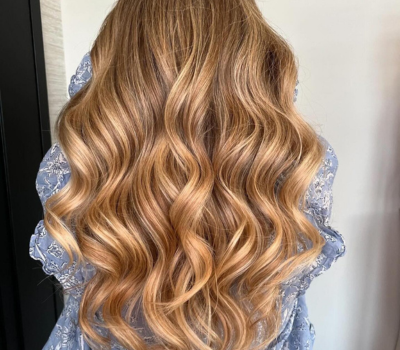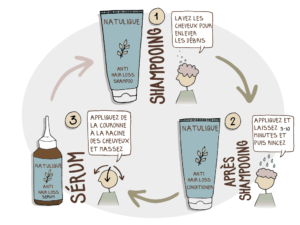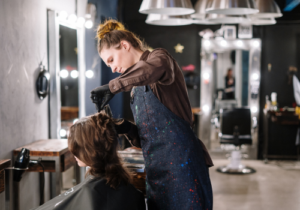"`html
Hair bleaching is a popular method of achieving a lighter shade, but it can sometimes give way to an undesirable yellowish effect. This can be annoying, but by understanding the root of the problem, it can be avoided and the desired hair color achieved.
Understanding the cause of yellowing after fading
Reasons for hair bleaching
A change of look
Many people opt for bleaching when they want to adopt a new style or follow current trends. Shades of blond remain popular, attracting those who wish to lighten their hair for a refreshing look.
Hide gray hair
To conceal gray or white hair, bleaching can be an effective solution. It camouflages these signs of hair aging, while harmonizing the overall color.
Why does a yellowish effect appear?
Chemical reaction of the bleaching process
In bleaching, hydrogen peroxide is commonly used to break down the hair's melanin and bring out the lighter pigments. However, this chemical reaction doesn't always end well, sometimes leaving a yellow residue, especially if the orange pigments are not completely bleached.
Result of uneven application of bleaching agent
Incorrect or incomplete application of the bleaching agent can also result in uneven shades. Sometimes, certain areas don't receive enough product, which may be due to poor product distribution or too short an application time. These errors can leave some areas with more yellow than others.
“`

"`html
Prevent the appearance of a yellowing effect
Choosing the right bleach for your hair type
The different types of bleach
There are various types of hair bleach, each with its own specific features and results. Powder bleaches offer rapid action and are often used for significant transformations. Cream bleaches, on the other hand, are gentler and more suitable for general applications, as they offer more precise control thanks to their texture. Making the right choice according to your hair objective and desired intensity is essential to minimize the yellowing effect.
Choosing the right bleach for your natural hair color
Your hair's natural color strongly influences the type of product to choose. For dark hair, a powerful bleach may be needed to break down the more resistant pigments. On the other hand, for light hair, a gentler formula may be sufficient to avoid damaging the hair fiber and limit the appearance of yellowish highlights. Adapting the choice of bleach to the hair's initial color gives you greater control over the result.
How to apply bleach correctly
Use of appropriate applicators
The use of suitable applicators, such as brushes or color-specific combs, is crucial to ensure even product distribution. Brushes allow you to reach the roots with precision, while combs facilitate product penetration between strands, avoiding excessive build-up that can lead to uneven results.
Uniform application procedure
For a successful application, it's essential to follow a well-defined procedure. Start by separating your hair into sections to facilitate layer-by-layer application. Apply the bleach evenly, starting with the most resistant areas, generally the lengths and ends of the hair, before moving on to the roots, which are more sensitive and lighten more quickly. Strictly observe the indicated application time to avoid leaving the product on too long, which could intensify yellowing.
“`
See also: Botanical hair color: benefits and application tips
"`html
Fighting the yellowing effect after fading
Use targeted hair care products
Dejaunizing shampoos
To counteract unwanted yellow tones, dejaunizing shampoos, often enriched with violet or blue pigments, are an effective solution. These products act as a color corrector, neutralizing yellow highlights by depositing opposite pigments on the color wheel. For optimum results, we recommend using these shampoos once or twice a week, leaving them on for a few minutes before rinsing. This helps maintain a luminous color without traces of yellow, making it easier to maintain blonde color.
Oil baths
Oil baths are also an effective way of reducing the yellowing effect, while promoting overall hair health. Natural oils such as coconut or argan oil nourish hair deep down, helping to repair and rehydrate hair fibers weakened by bleaching. Apply the oil generously to the entire head of hair, leave on for several hours or even overnight, then rinse thoroughly. This not only strengthens the hair, but also reduces the intensity of yellow highlights, restoring natural shine to blond locks.
Advanced techniques for reviving color
Hair toners
For more targeted, long-lasting action, we recommend the application of a hair toner. Toners, available in several shades, are specially formulated to adjust the tone of bleached hair. They are applied after bleaching to neutralize yellow highlights and create a more even, cooler shade. When choosing a toner, opt for the one that best matches the final color objective, guaranteeing impeccable results. This technique does, however, require regular maintenance, as highlights can reappear with each wash.
Hair Glossa
Hair glossa is another advanced method for adding shine and homogeneity to bleached color. This semi-permanent treatment works by forming a protective layer around each hair, ensuring optimal light reflection, which visually enhances color and reduces yellow highlights. What's more, glossa can intensify the desired hue, whether to enhance cool tones or add soft warmth to highlights. However, this treatment requires professional application to ensure correct distribution and avoid uneven results.
Adopt an appropriate washing routine
Water temperature
One of the simplest precautions to incorporate into your washing routine is regulating the water temperature. Hot water can open up the hair cuticle, making pigments more susceptible to fading and revealing yellow highlights. Use lukewarm or even cold water for the final rinse, which helps seal the cuticle, preserving the shine and intensity of the color.
Washing frequency
Reducing the frequency of washing is also beneficial for maintaining color. The more you wash your hair, the more it loses the pigments deposited by bleaches or toners. Opt for a dry shampoo between washes to keep your hair fresh without exposing it too often to water, which could deliver yellow highlights too soon.
“`
Complementary care and home tips
Use of professional care
Professional hair masks
Professional hair masks are designed to deep-treat hair after bleaching. They provide intense hydration and add nutrients to restore hair structure. Use masks specially formulated for color-treated hair, which may also contain neutralizing agents to reduce yellowish highlights.
Consultation with an experienced colorist
When a yellowish effect persists despite home care, consulting an experienced colorist may be a wise solution. Thanks to his or her expertise, he or she will be able to suggest additional treatments, adjust coloring or recommend specific products adapted to your hair type and its condition after bleaching.
Home remedies
Yogurt and honey mask
Yogurt and honey form a nourishing duo for your hair. Yogurt contains lactic acid, which helps naturally lighten hair, while honey strengthens and moisturizes. To make this mask, mix equal parts yogurt and honey, apply to damp hair, leave for 30 minutes, then rinse thoroughly.
Chamomile infusion
Chamomile is well known for its natural lightening properties. Prepare a concentrated infusion of chamomile, leave to cool, then apply as a final rinse after shampooing. Used regularly, it can help neutralize yellow tones and give hair a more golden, natural shine.
Tips to prolong results
Sun protection
The sun can intensify the yellowing of bleached hair. Protecting your hair with a hat, scarf or UV protective spray can help preserve your color. Invest in hair products containing UV filters to provide an additional barrier against sun damage.
Avoid excessive use of heat
Reducing the use of heat tools is essential to maintaining the color and health of bleached hair. Prefer natural styles and use heat-protective products before any blow-drying or hot styling. This helps minimize pigment loss and dryness, which often accentuate yellow tones.
FAQ : Frequently asked questions
What's the difference between a toner and a dejaunizing shampoo?
A toner is applied in the salon to adjust the overall shade, while a dejaunizing shampoo is used at home to maintain color between visits to the hairdresser.
Can cider vinegar help reduce yellowing?
Yes, cider vinegar can help balance hair pH, helping to reduce the appearance of yellowish tones.
How often should I use a hair mask?
It's generally advisable to use a hair mask once a week to keep hair hydrated and healthy.
How do I know what type of bleach to use?
Consult a professional to determine the type of bleach best suited to your pigmentation level and scalp sensitivity.
Can the sun affect my color after bleaching?
Absolutely, the sun can accentuate yellowing, so it's advisable to protect your hair from UV rays.




